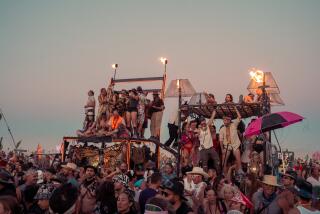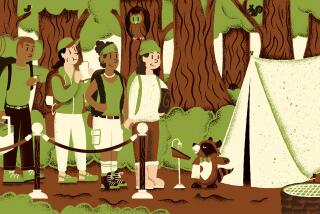British Columbia’s cold comfort
- Share via
It was the low, snuffling growl that infiltrated my dreams and conjured visions of grizzly bear attacks. My eyes flew open, and I realized the growling was stereo snoring from two companions whose cacophonous grunting would rattle the window panes — if there were any. Which, in this igloo, there weren’t.
It was time to step outside.
It was a crisp, dead-of-winter night in the majestic mountains of British Columbia, and this forested plateau a few hours from Vancouver was illuminated by a nearly full moon. Deciduous trees and skeletal bushes were heavy with snow, and there was the kind of thick silence that one rarely encounters in the city. I panned around and found two alien bumps in the otherwise untouched powder.
The igloos that sprang from hours of labor and buckets of sweat were, miraculously, still standing.
Skiing, snowboarding and snowshoeing are second nature in British Columbia, where driving from downtown to snowcapped mountains can take less than an hour. Igloo camping, although not yet common, is catching on as a challenging way to interact with this backyard winter wonderland.
I’m from the traditional school of holidaymakers who believe vacations should be about rest and relaxation. But when romantic notions of adventure temporarily overpowered my cranial center of logic, I agreed to join five friends for their annual overnight expedition. Never much of an outdoorsman, I was about to take a strenuous crash course in winter camping.
After an early-morning drive in two cars from our homes in Vancouver to Squamish, a small British Columbian logging town 30 miles north of the region’s main city, the six of us gathered bleary-eyed at the foot of Round Mountain in Garibaldi Provincial Park. Garibaldi is one of western Canada’s most popular outdoor adventure destinations, encompassing almost a half a million acres of undeveloped mountain wilderness including glaciers, alpine lakes and rugged snow-capped peaks.
Many British Columbians have a not-so-secret addiction to outdoor equipment. I’m not one of them. My own winter wear amounted to one oversized woolen hat; I was, for this trip, transformed into a walking garage sale of borrowed gear.
Fellow campers sported coordinated fleece and Gore-Tex gloves while I stood around looking goofy in red Santa Claus pants, black rubber boots and a hand-me-down blue jacket. After fumbling with the straps on my rented snowshoes, I hoisted on a borrowed backpack stuffed with 50 pounds of essentials such as toilet paper, extra socks and a heavy complement of alcohol, decanted into plastic bottles and intended for later consumption.
We were hauling enough gear to cover any eventuality in a region where overnight temperatures often fall to below zero. Required equipment included winter sleeping bags, head-mounted flashlights and emergency tents. Each hiker also carried a collapsible snow shovel, an extendable snow probe for revealing snow depths and an electronic transceiver that picks up signals from anyone unfortunate enough to be buried under an avalanche.
After the hike, build an igloo
The hike was a tough two-hour upward trek among giant fir, cedar and hemlock trees, each draped with a thick covering of snow. The occasional trickle of water broke the near silence as we wound our way along paths that were just a few feet from dark, impenetrable forest on one side and close to the edge of steep, rocky cliffs on the other.I followed the leader most of the way, keeping my eyes on the backs of his snowshoes to help maintain my own walking rhythm. Because the day was warm with a blue sky, most of us were sweating within minutes so we quickly removed hats and jackets. We took frequent water stops, which enabled us to take in the spectacular views of the unfolding valley below.
Evidence of human encroachment here included the low buildings of Squamish and the cleared site of a future university, but the lush, green forests and twinkling river deltas below the snow line dominated the area, stretching as far as the eye could see.
After an hour, it was time to stop for lunch. My pockets were stuffed with chocolate and trail mix for snacking, but the shared meal was a gourmet affair of foil-wrapped chicken breasts, French bread and Brie sandwiches and home-baked cookies. Each of us also carried several liters of bottled water; munching on snow is not advisable for long periods because it dries the mouth, although melted it makes a passable cup of tea.
When we finally reached our plateau in a clearing around 5,000 feet, my jelly-like legs were starting to buckle. I peeled off my backpack, and those muscles that had gotten an unexpected workout made me wince in pain. But there was no rest for the weary. Instead, we had to start building immediately because only a few hours of sunlight remained.
I glanced around the group hoping for sympathy, but most were busy stretching their arms, legs and backs in preparation for the work ahead. Michael and Brad, expedition veterans, were the obvious building leaders. That left Richard, David, Dominic and me — the novices — to take orders from the experts and do whatever was required to earn our keep.
We divided into two groups, and, using our snowshoes, started stamping down the snow in two wide circles. The plan was to build two three-man igloos facing each other, divided by a trench that would serve as a makeshift open-air kitchen.
We began digging in each of our circles to about 4 feet, using shovels and machetes to remove the packed snow in rough, rectangular blocks. These blocks, each about the size of two large shoeboxes and about as heavy as a large sack of potatoes, were stacked haphazardly around the two perimeters until we had gathered enough to start.
Two of my team members remained in the pit to begin construction, but I continued digging for blocks in the kitchen trench. Slicing them was easy. The problem for me, given that I have the upper body of a desk-bound librarian, was the lifting.
Determined not to make excuses and despite burning legs, shaking arms and a spine taxed well beyond its natural threshold of pain, I cut, lifted and stacked more than 100 blocks during the afternoon, earning the nickname “block god.”
The igloos only faintly resembled the perfect domes of childhood cartoons. Tilted and placed on top of one another in a spiraling, inward curve, they pushed together to support one another like a keystone arch. Gaps in the igloo wall were smoothed over with handfuls of snow. The entrance, rather than being on the surface, was a short U-shaped tunnel dug under the snow to prevent the wind from whistling into our abode.
As each dome rose and began closing at an apex of around 6 feet, my feeling of exhaustion was slowly replaced by a sense of accomplishment in the making. With hot drinks regularly supplied from two small camp stoves, I was enjoying the work.
Cross-country skiers shuffled by, and many stopped to check us out: Igloo camping may not be unique in these parts, but it can still raise an eyebrow or two. Inquisitive whiskey jacks, one of the region’s most common bird species, also frequently dropped by, although they were more interested in our snacks than in our construction project.
After five hours, the final blocks were maneuvered into place, and we stood back to admire our handiwork, discovering that the two igloos had turned out quite differently.
The other group had produced an almost perfect dome, but ours resembled a half-egg turned on its side. Debate about the merits of each construction quickly degenerated into a snowball fight. Then we realized we hadn’t quite finished the kitchen.
Using the trench I had excavated for the building blocks, we haphazardly dug out some seats and shelf space from the snow. Rough steps were quickly cut, and the trench was adapted so each igloo entrance opened into it.
We built a fire in the kitchen and relaxed, congratulating ourselves and downing some rehydrated pasta and celebratory alcohol. By 9:30 p.m., in the kind of inky darkness city-dwellers rarely encounter and after the exertion and alcohol, it was time for bed.
I ducked and slid through the U-bend entrance and crawled into one of the three sleeping bags on the floor. Warmed by candles and sheltered from the cold, we were cozy enough.
One for the road
I slept fitfully, and dawn arrived too quickly. But the early-morning light that filled the igloo and turned the interior translucent was memorable. I was nearly euphoric except that the slightest movement reminded me of what I’d put my body through. I pulled on my boots and slid — painfully — through the entrance.We drank coffee, packed our gear and set about wrecking the igloos with several well-aimed kicks, a safety measure to prevent anyone from tumbling into the excavated pit or reusing a dangerously old structure.
The sunny descent, with much lighter loads and downhill momentum, was swift and enjoyable. We veered off the path to test our snowshoes in drifts as much as 10 feet deep.
Before returning to the city, we made a pub stop to resolve one argument: Who had built the better igloo? Never mind that it was 9:30 a.m. A pint of ice-cold beer and a greasy, deep-fried breakfast never tasted so good.
And, not surprisingly to us, the egg-shaped igloo was voted the superior dwelling. Unless, of course, you asked the other team.
*
(BEGIN TEXT OF INFOBOX)
What to brrrrring
GETTING THERE:
From LAX, Air Canada, Alaska, Northwest and United offer nonstop service to Vancouver, and Delta and America West offer connecting service (change of plane). Restricted round-trip fares begin at $188.
IF YOU GO:
Igloo camping is not for the uninitiated or unprepared. Some winter backpacking experience is recommended, and basic gear — boots, gloves and waterproof jackets — is essential. Snowshoes, probes, transceivers, spades and winter sleeping bags can be rented from Vancouver outdoor stores.
Canada West Mountain School offers several guided winter camping tours in British Columbia, along with courses in igloo and snow shelter building. The 20-year-old company, a former division of the Federation of Mountain Clubs of British Columbia, can also provide guides for customized trips. Prices for guided tours start at around $150 per person. For more information, call (604) 878-7007 or go to https://www.themountainschool.com .
TO LEARN MORE:
Canadian Tourism Commission, (213) 346-2700, https://www.travelcanada.ca .
— John Lee
More to Read
Sign up for The Wild
We’ll help you find the best places to hike, bike and run, as well as the perfect silent spots for meditation and yoga.
You may occasionally receive promotional content from the Los Angeles Times.






